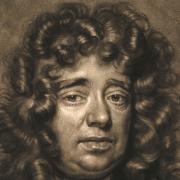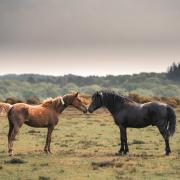Journo, author, commentator, poet, hymnwriter, onetime Southampton ‘bobby’, and connoisseur of vino who loved his native county, John Arlott was a humble yet much loved representative of Hampshire
Born on February 25, 1914, in Basingstoke at Cemetery Lodge, Chapel Hill, Lester Thomas John Arlott was the son of cemetery registrar, William Arlott, and Nellie née Jenvey-Clarke. An interesting place to be born, a Listed Gothic building on the site of the old Holy Ghost chapel ruins, the Lodge guards the entrance to today’s Holy Ghost Cemetery in the centre of Basingstoke where famous incumbents include clothing manufacturer Thomas Burberry, Alfred Milward of Milwards Shoes, a Mrs Blunden who was buried alive here twice, and John Aidan Liddell VC. Arlott lived here for several years.


He was schooled in the town at Fairfields Primary (from 1920) and then Queen Mary’s Grammar. Arlott was into cricket from an early age and in 1926, aged 14, watched England tussle with Australia at The Oval. When he left school, John, as he’d become known, had a brief employ at the town hall where he studied typing before he enjoyed a longer stint at Park Prewett Hospital as a records clerk (1930-34). It’s fair to say he hadn’t yet found his calling. He then spent 12 years working in policing (1934-46) in the Southampton County Borough Force, becoming a sergeant. Being a Southampton ‘bobby’ gave Arlott scope to watch Hampshire County Cricket Club and he availed himself of that opportunity, frequently spectating at the old County Ground. He even represented the county, albeit only once and then as a substitute fielder, this auspicious event occurring against Worcestershire in 1938. He also studied at Southampton University library and midway through his dozen years on the beat was married to Dawn Rees in 1940 (they were divorced in 1958) with whom he had two sons.

Noted for his ‘poetic phraseology’ and Hampshire rusticity, Arlott conjured cricketing imagery as though the game was being played the other side of one’s living room window. His first commentaries came in 1946, during India’s tour of England, and he’d carry on living his dream until retiring in 1980. During this lengthy stint of 35 years, he commentated on every home Test match England played although he’d only tour twice, to South Africa (1948-49) and Australia (1954-55), plus he found his way to Australia again (1977) to commentate on the Centenary Test. The South African tour saw Arlott express his distaste for Apartheid; when asked to specify his race on an immigration form, he wrote ‘human’. He’d later befriend Basil D’Oliveira, who was banned from playing cricket in his native South Africa because of his race. There’d be a Kiplingesque assemblage of triumphs and disasters for the team throughout all this but only triumphs for a man born for the mic.
Arlott’s journalistic career began in 1950 with London’s Evening News and he began reporting on football matches in 1958 for The Observer, going on to be chief cricket correspondent for The Guardian (1968-80). One of Arlott’s earliest football assignments should have been the Red Star Belgrade versus Manchester United European Cup match in February 1958 except for a last-minute change of personnel which saw Harry Donald (Donnie) Davies sent instead. Tragically the team’s plane crashed at Munich-Riem Airport resulting in the deaths of 23 players and journalists including Davies.

One lesser-known fact about Arlott is his standing for the Liberals in the 1955 and 1959 General Elections. His political leanings reflected the man; he was gentle, middling and never extreme in view or behaviour. He also perhaps had a fondness for the underdog which the Liberals certainly were, their legislating days long gone. ‘Test Match Special’, meanwhile, that uninterrupted ball-by-ball commentary cricketing aficionados revere, was launched in 1957 and Arlott became a fixture. When he retired in 1980, he was the longest-serving TMS commentator. He’d also been a panellist on ‘Any Questions?’ and twice appeared on ‘Desert Island Discs’ (1953 and 1975).
Arlott also became a literary producer with the BBC, working with E.M. Forster and John Betjeman, who became something of a mentor, poetically at least, and the tragic Dylan Thomas who became a good friend. Arlott had something of Betjeman and Thomas about him when he eulogised about willow thwacking leather. Some of Arlott’s descriptions were worthy of Betjeman. Once when Mann was bowled by Mann, Arlott spoke of ‘Mann’s inhumanity to Mann’ (during that South African tour), whilst a later example of his whimsy described a shot by West Indian batsman Clive Lloyd in 1975: ‘The stroke of a man knocking a thistle top off with a walking stick’. Another classic came in 1977 commentating on that Centenary Test ‘down under’. The Australian fast bowler Dennis Lillee was in the firing line when Arlott observed: ‘The seagulls standing in line like vultures for Lillee’. These were among his best ‘Arlottisms’.

Arlott married for a second time to Valerie France in 1959 with whom he’d have a third son; she’d predecease him in 1976. They lived in New Alresford, in the former Sun Inn, from 1961, with John remaining until 1981. Tragically, he lost his eldest son in a car accident on New Year’s Eve, 1965. He’d moved into TV commentating during that time too and was presenting the Sunday League (1969-80). Arlott became President of the Cricketer’s Association in 1968, doing his bit to improve the county cricketer’s lot, and was awarded an OBE in 1970. Arlott’s third and final marriage was to Patricia Hoare in 1977 whilst his final commentary was the Gillette Cup final of 1980. Another close friend in Arlott’s latter years was the great all-rounder, Ian Botham. They were perhaps unlikely friends, but they hit it off. Botham was included in Arlott’s ‘Dream Team’, as was the aforementioned D’Oliveira. John Arlott’s autobiography, ‘Basingstoke Boy’, was published a decade later in 1990. He actually wrote approaching 40 books, unsurprisingly mostly about Cricket, but also an eclectic mix including wine, cheese and snuff, the 1953 Coronation, the Scilly Isles, other sports including football, and in collaboration with Galton and Simpson, a book about another tragic figure, comic actor Tony Hancock.
John Arlott died on December 14, 1991 in the Channel Islands aged 77. As a person he was content, never hankering for more, but quietly happy with life, in fact, he considered himself among the really fortunate. He had an independent mind, believed in fairness and justice, espoused the underdog, and rejoiced in anything ‘beautiful and good’.

CHRONOLOGY
1914 – Lester Thomas John Arlott born in Basingstoke, Hants (February 25).
1930 – First significant job as a records clerk at the Park Prewett Hospital, Basingstoke.
1934 – Begins a 12-year stint with the police in Southampton, becoming a sergeant.
1938 – Makes a single First Class appearance for Hampshire as a substitute fielder.
1940 – The first of three marriages for John Arlott, to Dawn Rees, until 1958.
1946 – First cricket commentaries as India tours England.
1958 – Begins football commentaries and just avoids the Munich air crash.
1961 – Moves into the Sun Inn in New Alresford, renaming it The Old Sun (until 1981).
1980 – Retires from cricket commentary after the Gillette Cup final.
1991 – Death of John Arlott in the Channel Islands (December 14) aged 77.



























